Numerical Simulation and Experimental Study on Dynamic Characteristics of Gas Turbine Rotor System Subjected to Ship Hull Excitation
Abstract
1. Introduction
2. Fusion Model Vibration Response Characteristics
2.1. Ship Slice Model
- Slender body assumption: The x-component of the three components of the unit normal vector on the hull surface is significantly smaller than the y-component and z-component. Additionally, the flow field varies slowly along the longitudinal direction, as follows:
- The wave frequency is not too low and the speed is not too high:
- Regardless of the influence of steady disturbance potential , the following holds true:
2.2. Turbine Rotor System Model
2.3. Vibration Transmission Model
2.4. Vibration Transmission Analysis of Fusion Model
3. Experimental Study of Fusion Model
3.1. Ship Test Model
3.2. Ship Test Analysis
4. Comparative Analysis of Fusion Models
4.1. Acceleration Response
4.2. Root Mean Square (RMS) Acceleration
- (1)
- Front Bearing Point
- (2)
- Rear Bearing Point
5. Conclusions
- A simplified three-dimensional entity model of the turbine support ring was developed. The three-dimensional dynamic model for the whole machine vibration transmission was modified by material damping and a critical boundary. A ship slice model was developed based on the two-dimensional slice theory. A fusion model was constructed by combining the ship model test data. The acceleration response and RMS value were compared to validate the accuracy of the model.
- The high acceleration amplitude observed in the 1–2 Hz frequency range in the X and Z directions of the 18-knot head wave test was primarily due to the hull experiencing low-frequency and high-amplitude motion in the vertical, front, rear, and roll directions under the influence of head waves.
- Under the influence of a head wave load, the vibration output response at the bearing point before and after the wave load was calculated using the vibration transmission fusion model. The comparative test showed that the waveforms of the two were essentially the same. However, the obtained peak values of the vibration signal were slightly diminished compared to the input signal due to the effect of material damping. When the effective wave height was 0.5 m, the vibration response ratio outpaced the rest of the dataset. This was attributed to the change in the dynamic response characteristics under the action of the wave load, and the wave height was 0.5 m. Compared with the change in the vibration signal in the Z direction, the change in the vibration signal in the X direction produced a more obvious response. Specifically, the vibration signal in the Z direction was larger than that in the X direction. Furthermore, the amplitude of the vibration signal at the front bearing point was slightly higher than that at the rear bearing point.
Author Contributions
Funding
Data Availability Statement
Conflicts of Interest
Abbreviations
| FFT | Fast Fourier Transform |
| RMS | Root mean square |
References
- Gandzha, S.; Nikolay, N.; Chuyduk, I.; Salovat, S. Design of a Combined Magnetic and Gas Dynamic Bearing for High-Speed Micro-Gas Turbine Power Plants with an Axial Gap Brushless Generator. Processes 2022, 10, 1067. [Google Scholar] [CrossRef]
- Li, C. Analysis of the Misalignment-Imbalance Fault Characteristics and the Influence of Oil Inlet Pressure on the Elliptical Bearing Rotor System. Ph.D. Thesis, Xi’an University of Technology, Xi’an, China, 2022. [Google Scholar]
- Yuan, Z.; Shevchenko, S.; Radchenko, M.; Shevchenko, O.; Pavlenko, A.; Radchenko, A.; Radchenko, R. Studies on Improving Seals for Enhancing the Vibration and Environmental Safety of Rotary Machines. Vibration 2024, 7, 776–790. [Google Scholar] [CrossRef]
- Ren, Y.; Sun, X.; Luo, Y.; Lu, W.; Wang, H. Layering Vibration Transfer Path Analysis of a Flexible Supported Gear System Based on the Vibration Power Flow Theory. Processes 2023, 11, 1233. [Google Scholar] [CrossRef]
- Żywica, G.; Breńkacz, Ł.; Bagiński, P. Interactions in the Rotor-Bearings-Support Structure System of the Multi-stage ORC Microturbine. J. Vib. Eng. Technol. 2018, 6, 369–377. [Google Scholar] [CrossRef]
- Xie, C. Dynamic Characteristics Analysis of Floating Ring Bearing in Turbocharger Rotor System. Ph.D. Thesis, Taiyuan University of Science and Technology, Taiyuan, China, 2021. [Google Scholar]
- Zhang, J.; Fu, Z.; Yang, J.; Han, D. Experimental Investigation on the Influence of Bearing Supply Pressure on Gas Whip of the Rotor-Bearing Systems of High Speed Turbines. Noise Vib. Control 2015, 35, 195–199. [Google Scholar]
- Zhou, H.; Zang, C. Analysis of Dynamic Characteristics for the Rotor System in an Air Turbine Starter. Mach. Build. Autom. 2022, 51, 23–25. [Google Scholar]
- Wu, G. Research on Fault Excitation and Transmission Characteristics of Gas Turbine Rolling Bearings. Ph.D. Thesis, Harbin Institute of Technology, Harbin, China, 2021. [Google Scholar]
- Li, J. Research on Dynamic Stability of Two-Stage Turbine Bearing-Rotor System. Ph.D. Thesis, University of Chinese Academy of Sciences (The Institute of Engineering Thermophysics, Chinese Academy of Sciences), Beijing, China, 2018. [Google Scholar]
- Huang, Z.; Yuan, Q.; Yu, C.; Gao, J.; Kong, X. Research on Design Methodology for Similarity Test Model of Gas Turbine Rotor Dynamics. J. Xi’an Jiaotong Univ. 2023, 57, 78–88. [Google Scholar]
- Lei, D. Analysis of Coupled Vibration Characteristics of Aviation Turbine Engine Rotor-Helical Gear System. Ph.D. Thesis, Central South University, Changsha, China, 2022. [Google Scholar]
- Zhang, L.; Pei, S.; Xu, H. Research on Safety and Stability of Two Ship Rotor Bearing Systems under Swing Conditions. Sci. Sin. (Technol.) 2018, 48, 369–381. [Google Scholar] [CrossRef][Green Version]
- Han, Q.; Chu, F. Parametric instability of flexible rotor-bearing system under time-periodic base angular motions. Appl. Math. Model. 2015, 39, 4511–4522. [Google Scholar] [CrossRef]
- Pu, S.; He, Y.; Yang, Q.; Cheng, M.; Wang, Y.; Wang, Z.; Lin, Y. Study on Dynamic Characteristics of Rotor-Bearing System under Pitching Condition. J. Phys. Conf. Series. IOP Publ. 2021, 2113, 012021. [Google Scholar] [CrossRef]
- Wang, Z. Analysis and Experimental Study on Oil Film Characteristics of Ship Plain Bearing. Ph.D. Thesis, Zhejiang Ocean University, Zhoushan, China, 2023. [Google Scholar]
- Li, X.; Zhang, G.; Yang, Y. Kinematics Analysis of the 6-DOF Test-bed for the Sliding Bearing of Marine Gas Turbine. J. Phys. Conf. Series. IOP Publ. 2021, 1952, 032002. [Google Scholar] [CrossRef]
- Ding, K. Research on Design of Ship Plain Bearing-Rotor Test Platform and Swing Test. Ph.D. Thesis, Zhejiang Ocean University, Zhoushan, China, 2023. [Google Scholar]
- Wang, Q.; Xing, Z.; Liu, Y.; Li, M. Rubbing vibration characteristics of double-rotor system under wave load. J. Vibroeng. 2023, 25, 1–14. [Google Scholar] [CrossRef]
- Zeng, F.; Liu, Y.; Wang, Q.; Li, J. Simulation analysis of rolling bearings based on explicit dynamics. J. Phys. Conf. Series. IOP Publ. 2022, 2383, 012158. [Google Scholar] [CrossRef]
- Yang, W.; Liang, M.; Wang, L.; Yuan, H. Research on unbalance response characteristics of gas turbine blade-disk rotor system. J. Vibroeng. 2018, 20, 1676–1690. [Google Scholar] [CrossRef]


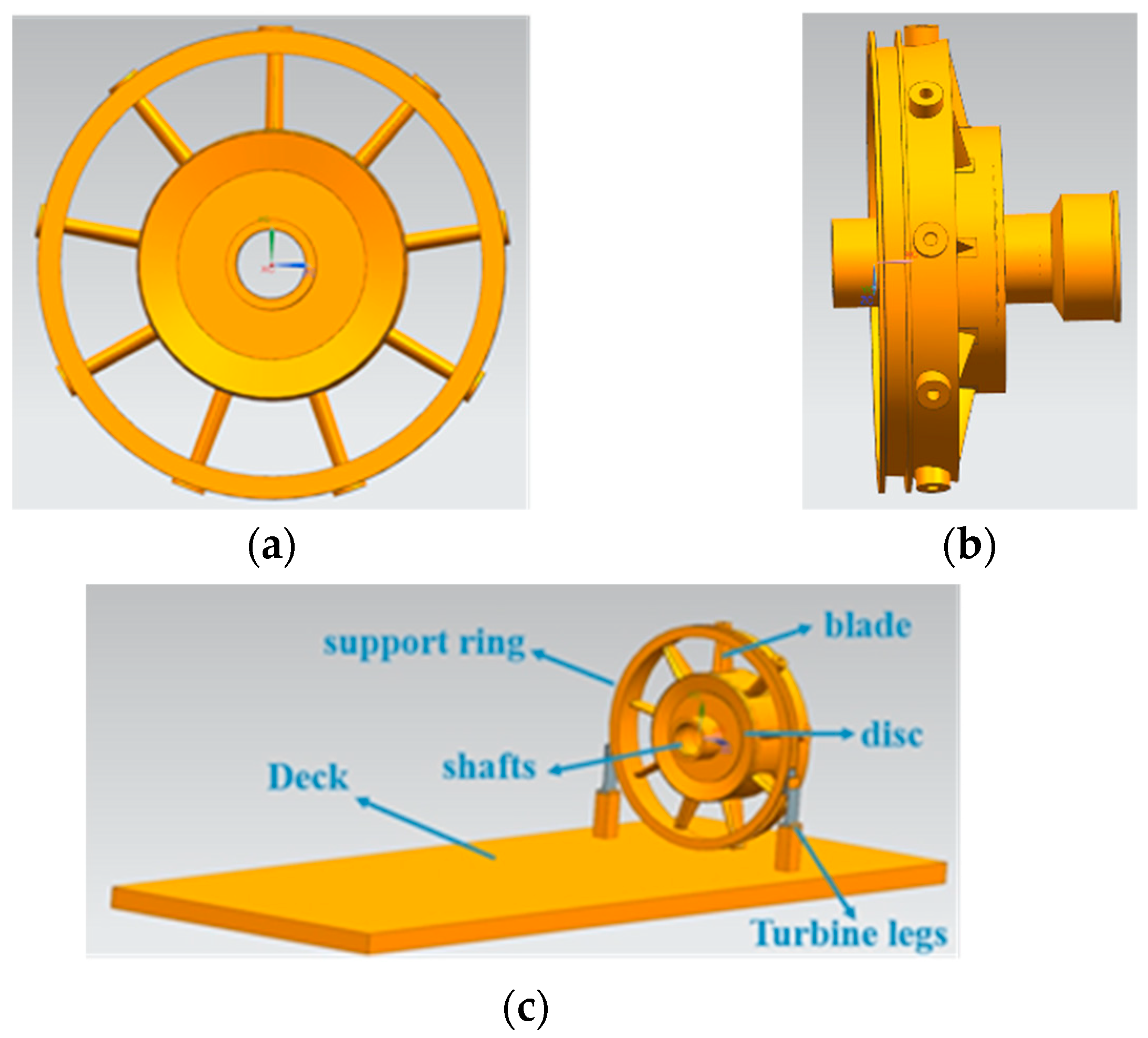
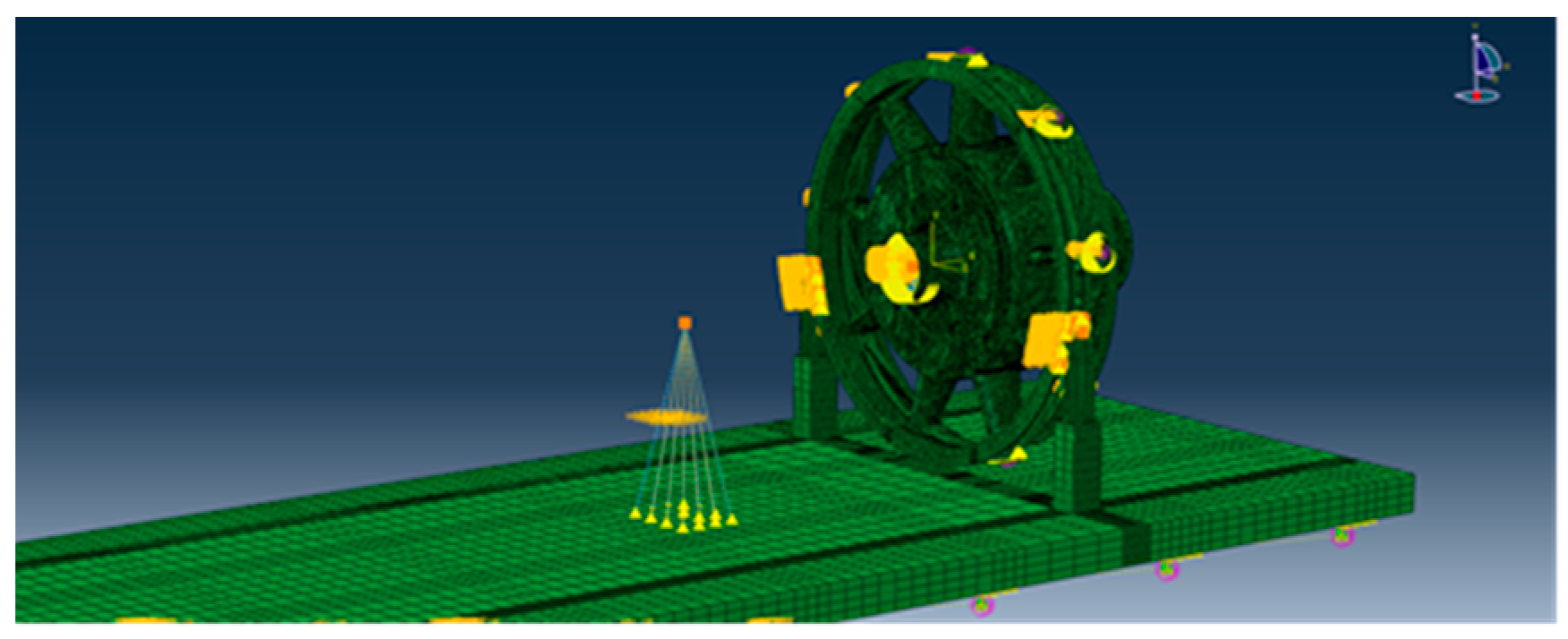
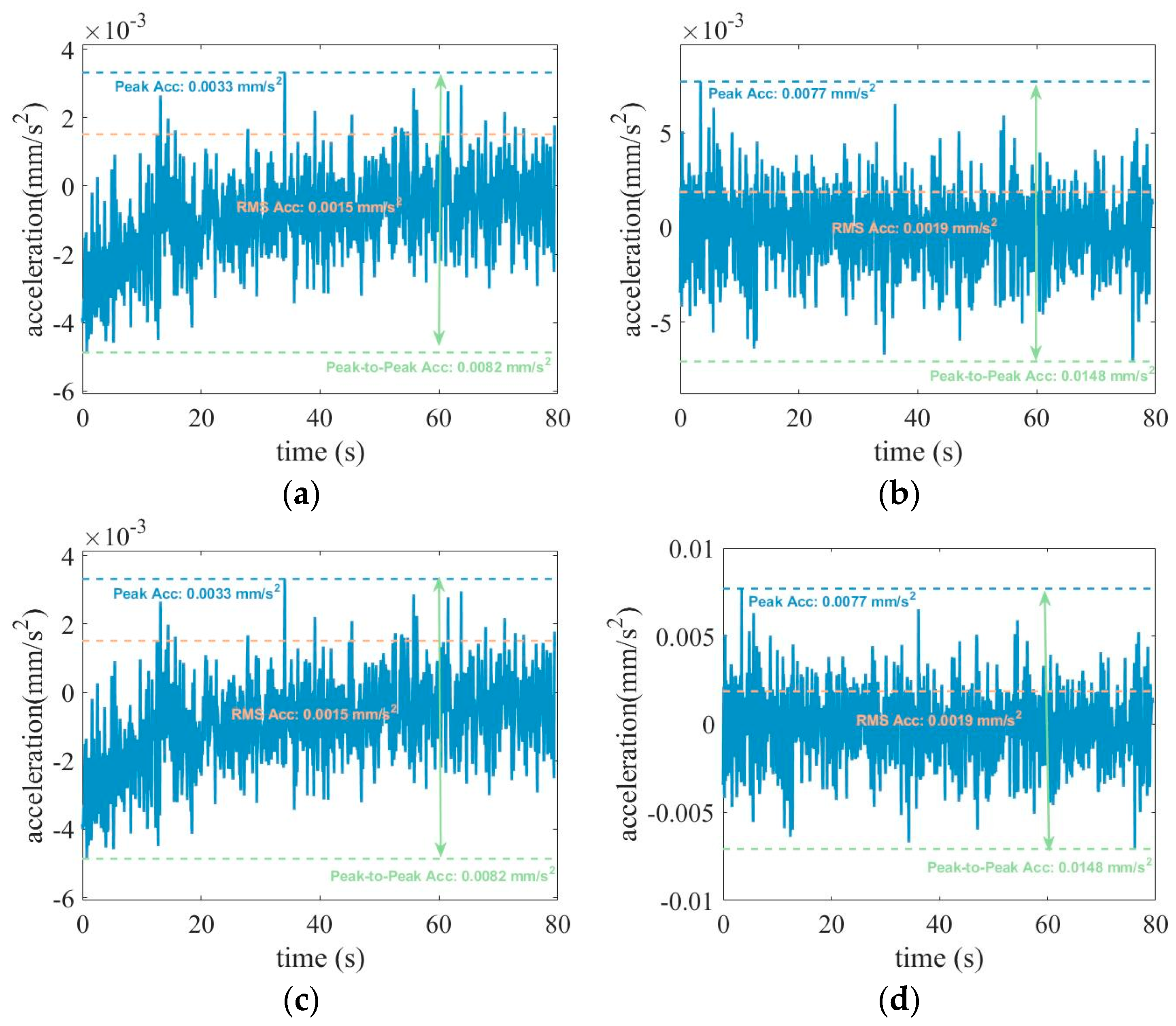

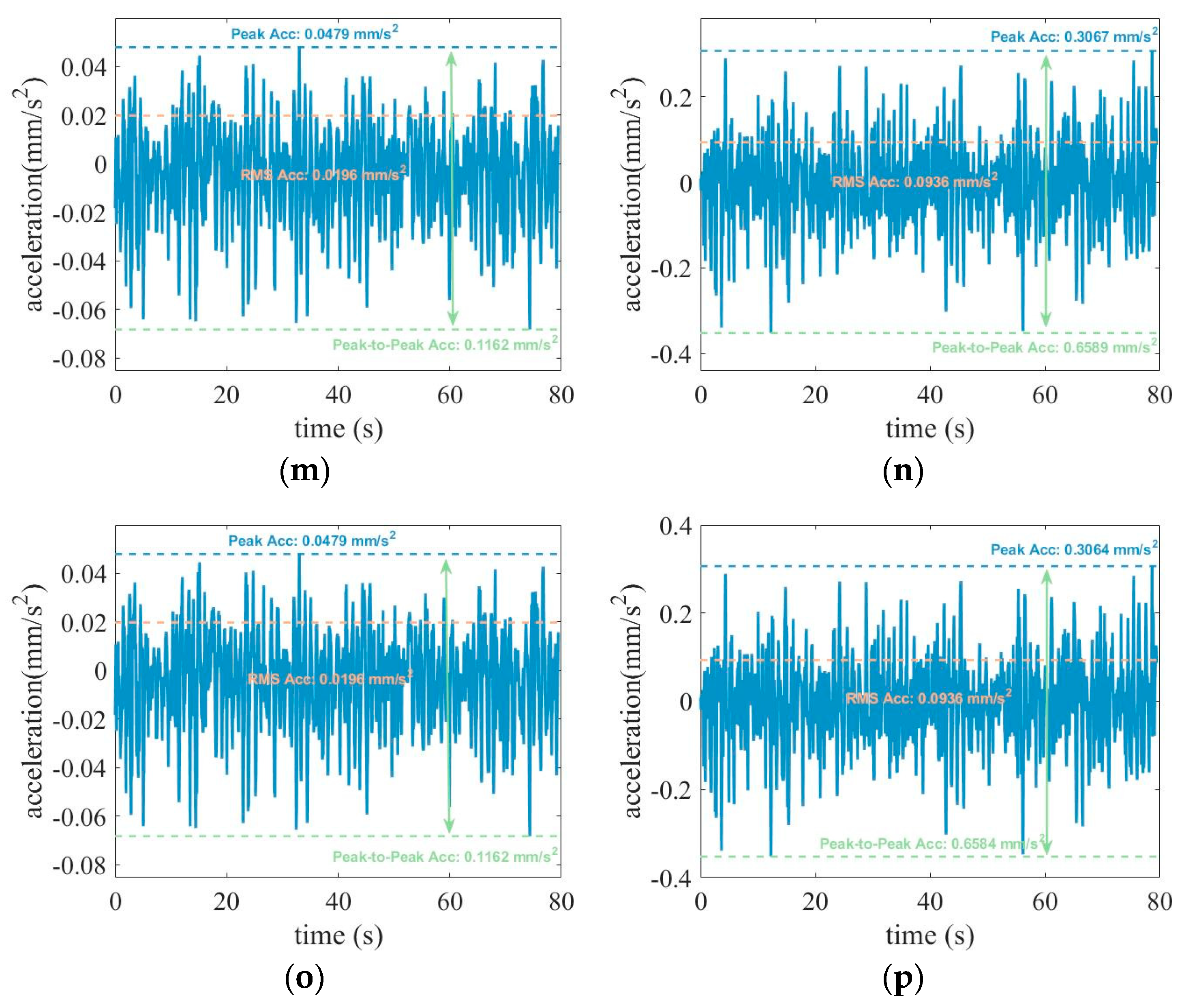
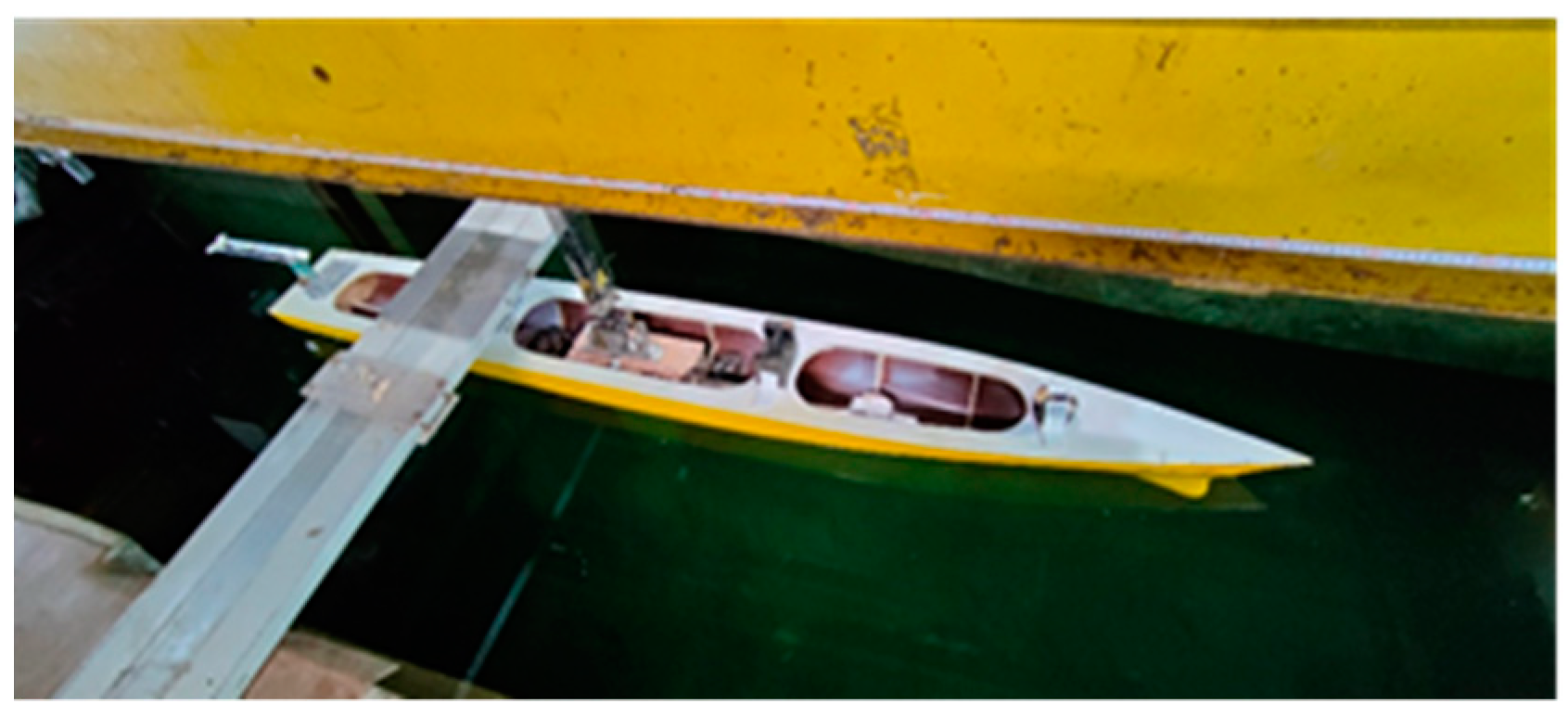

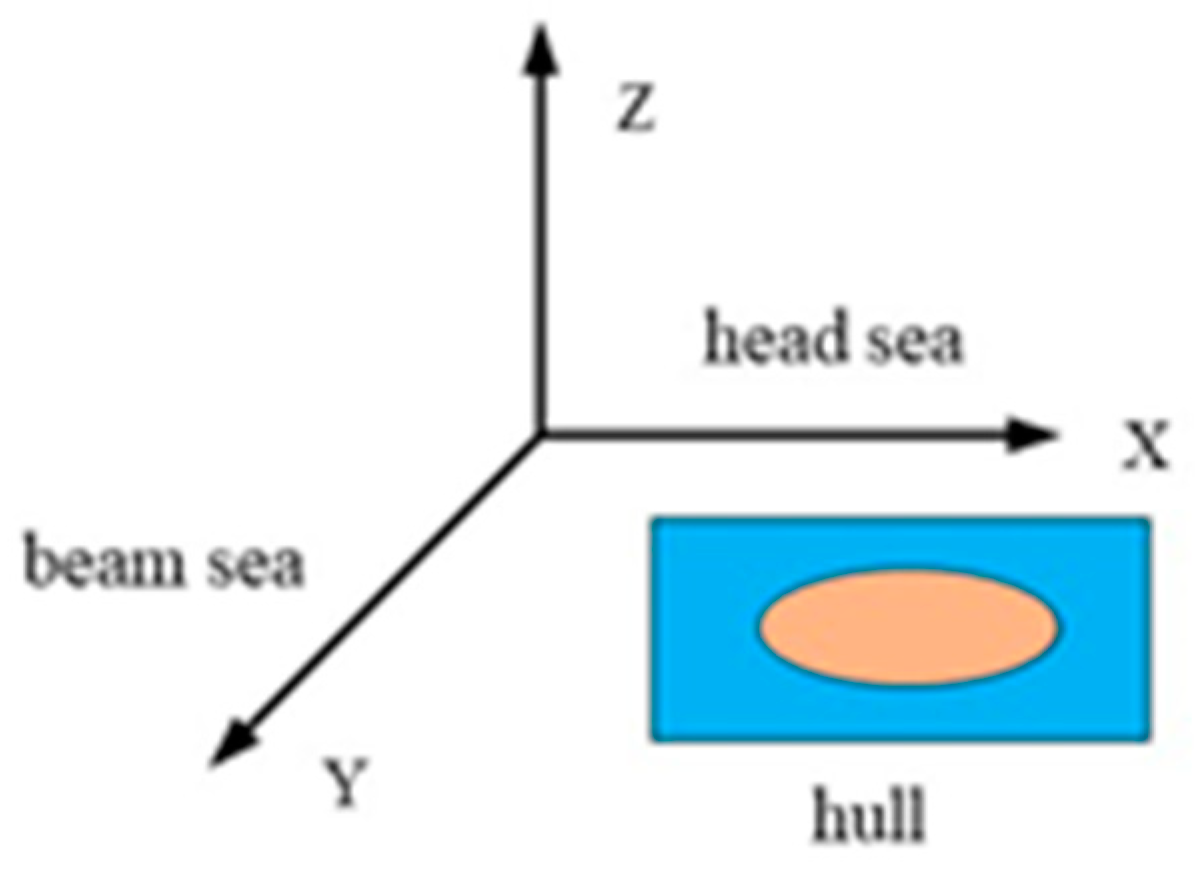

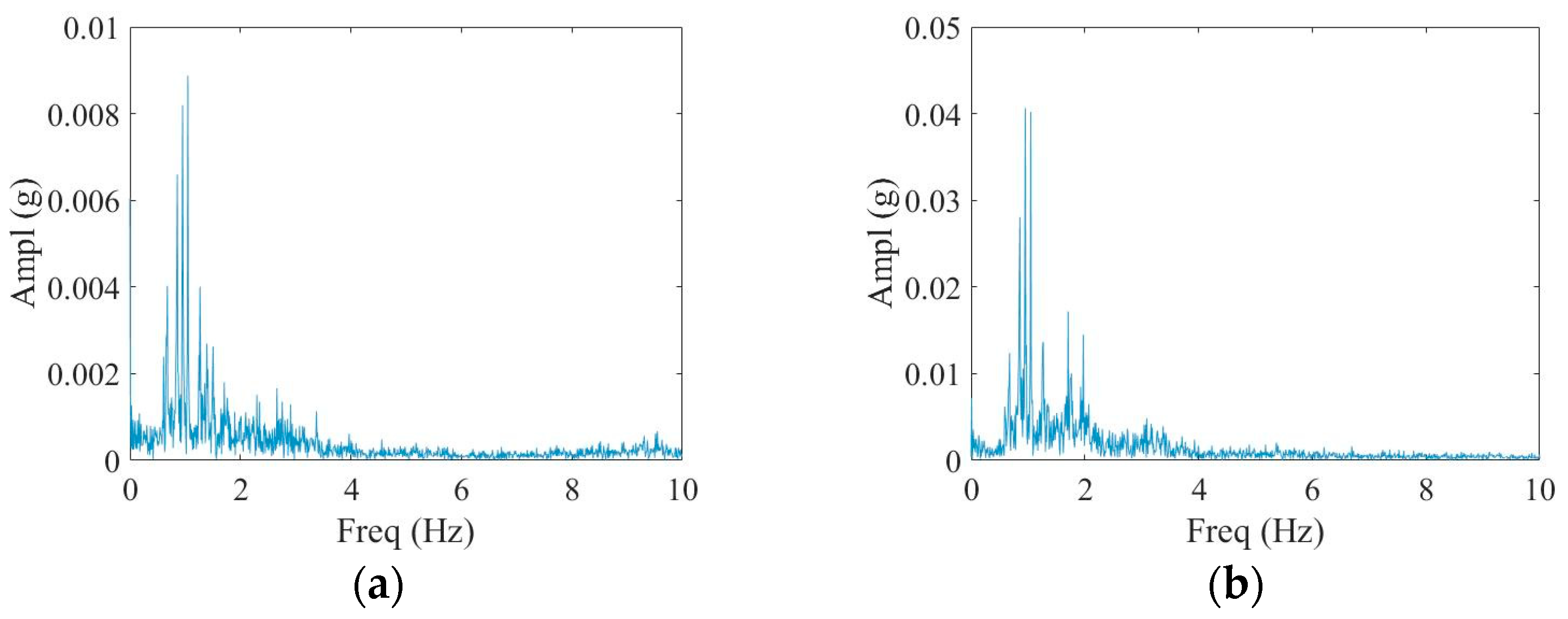
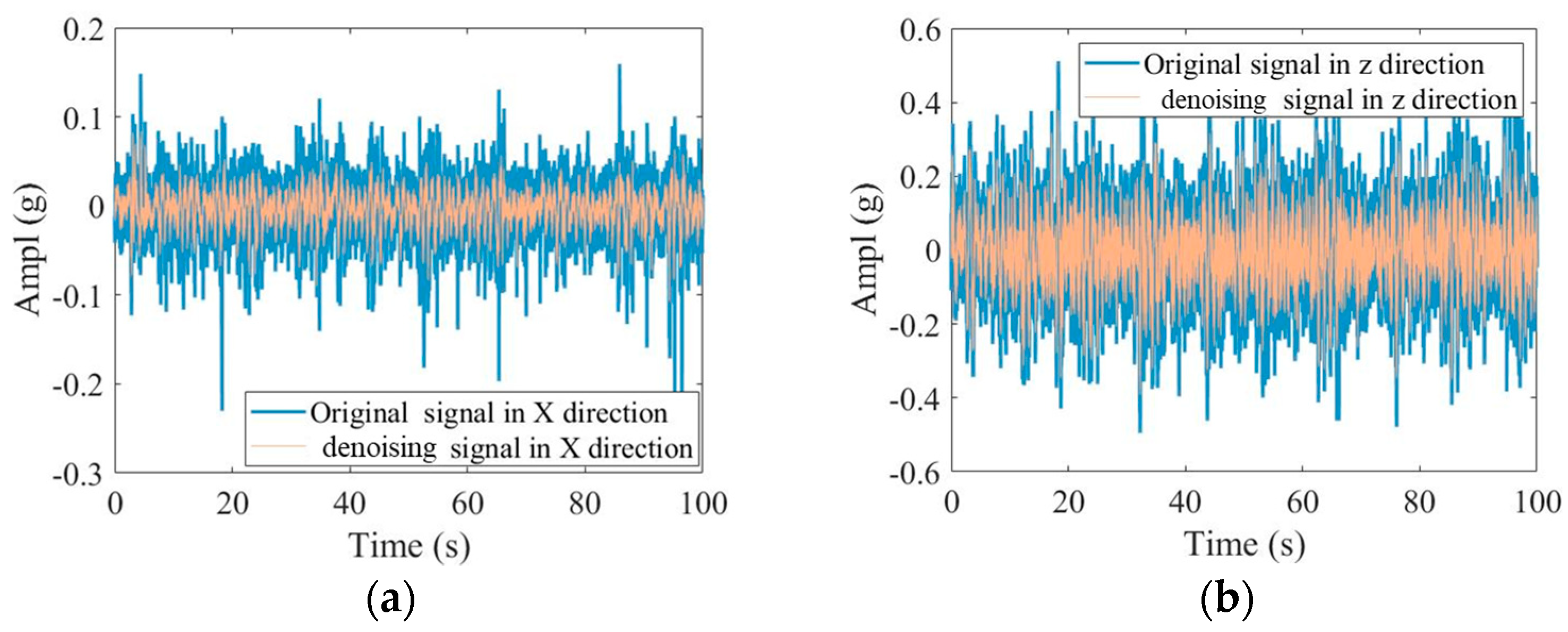
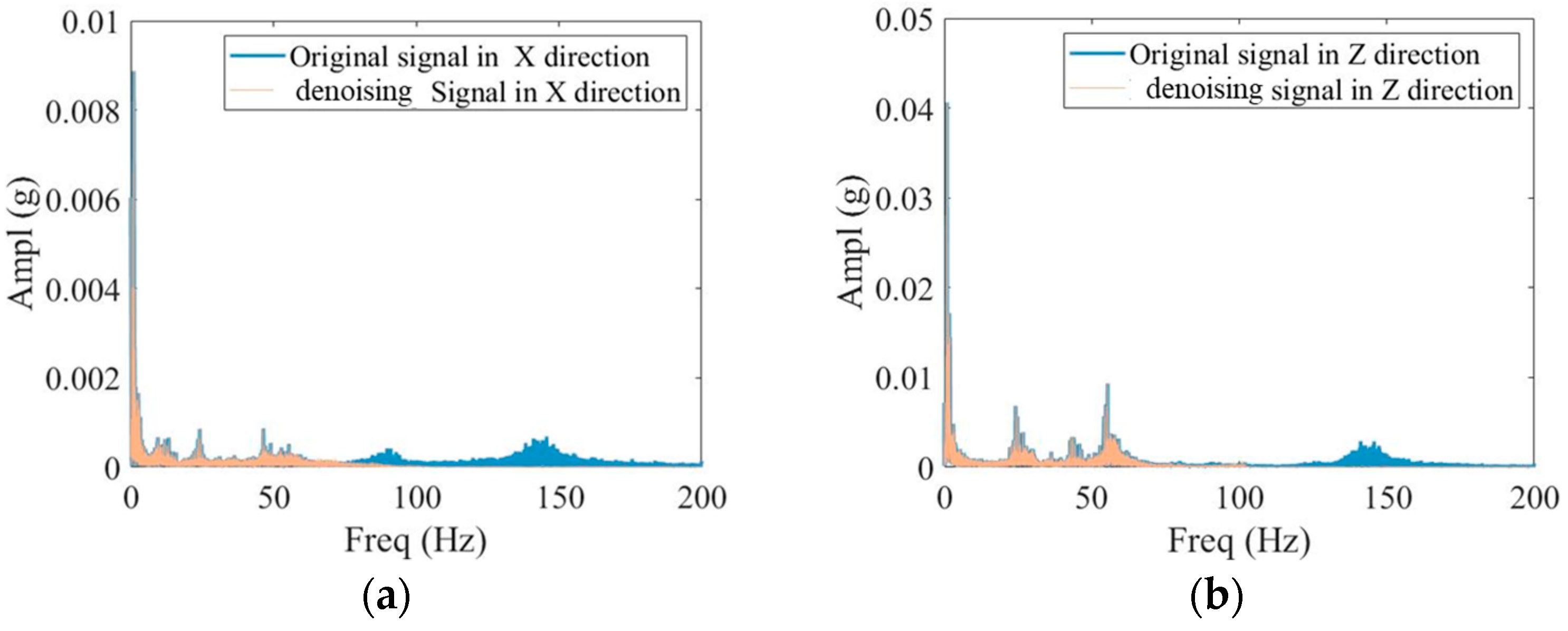
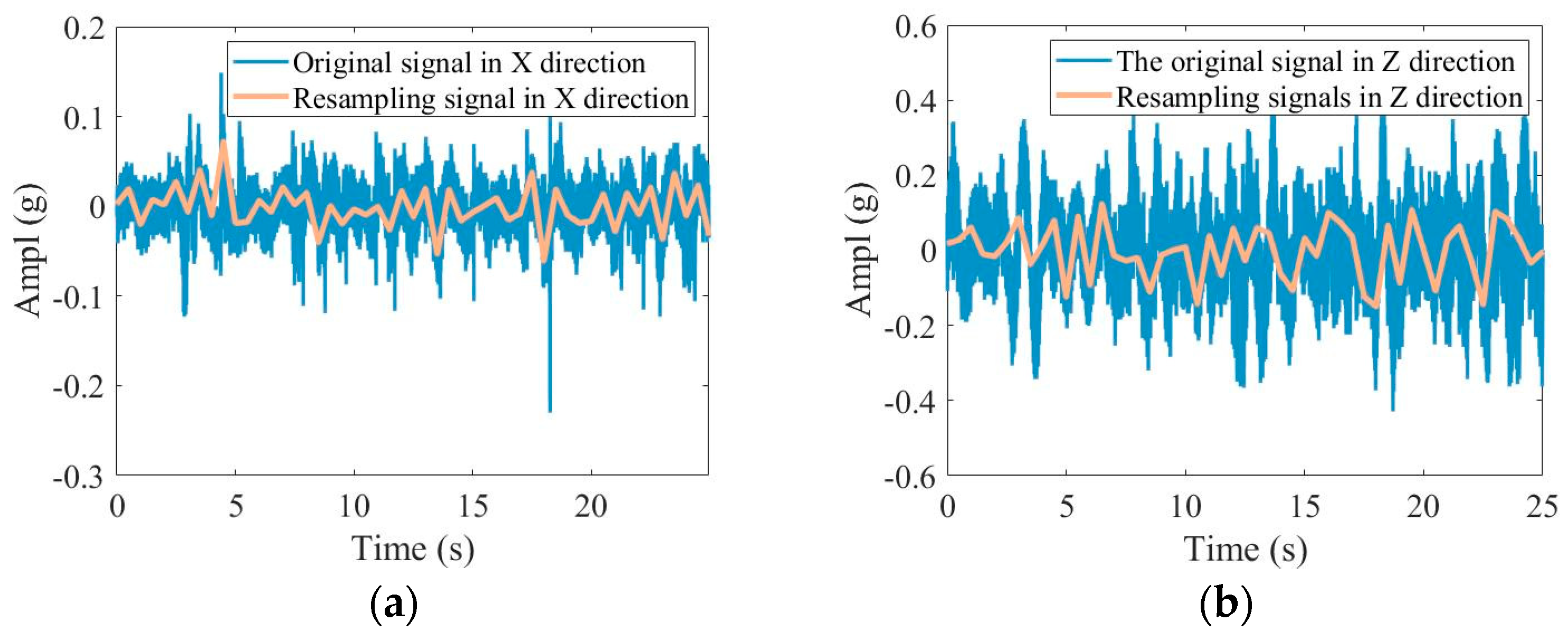

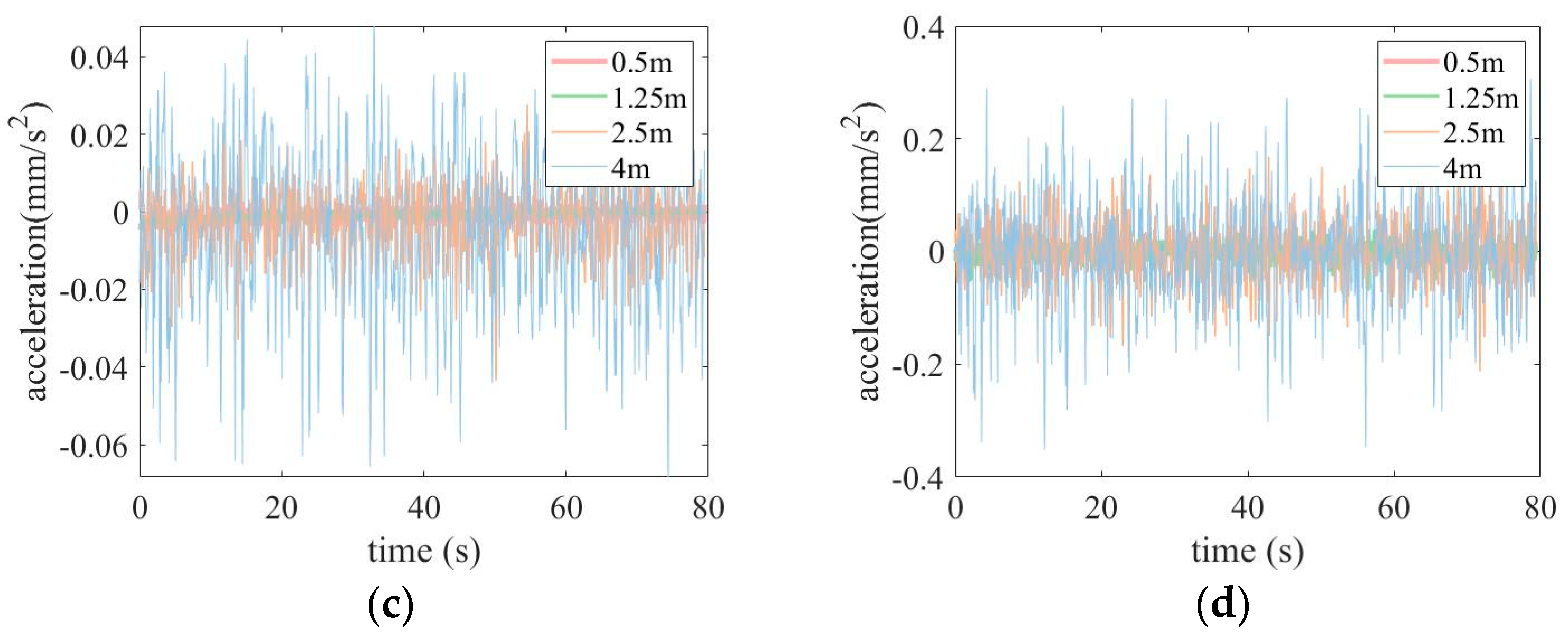
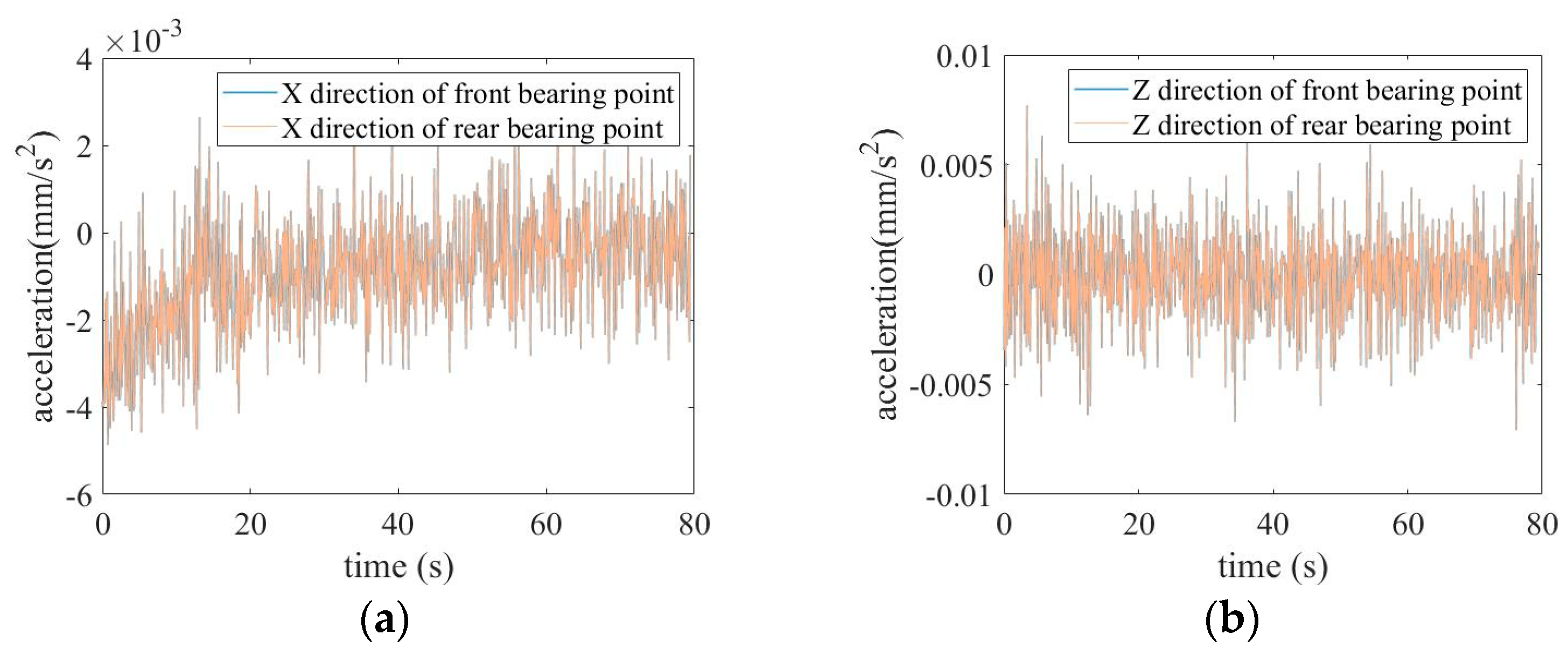
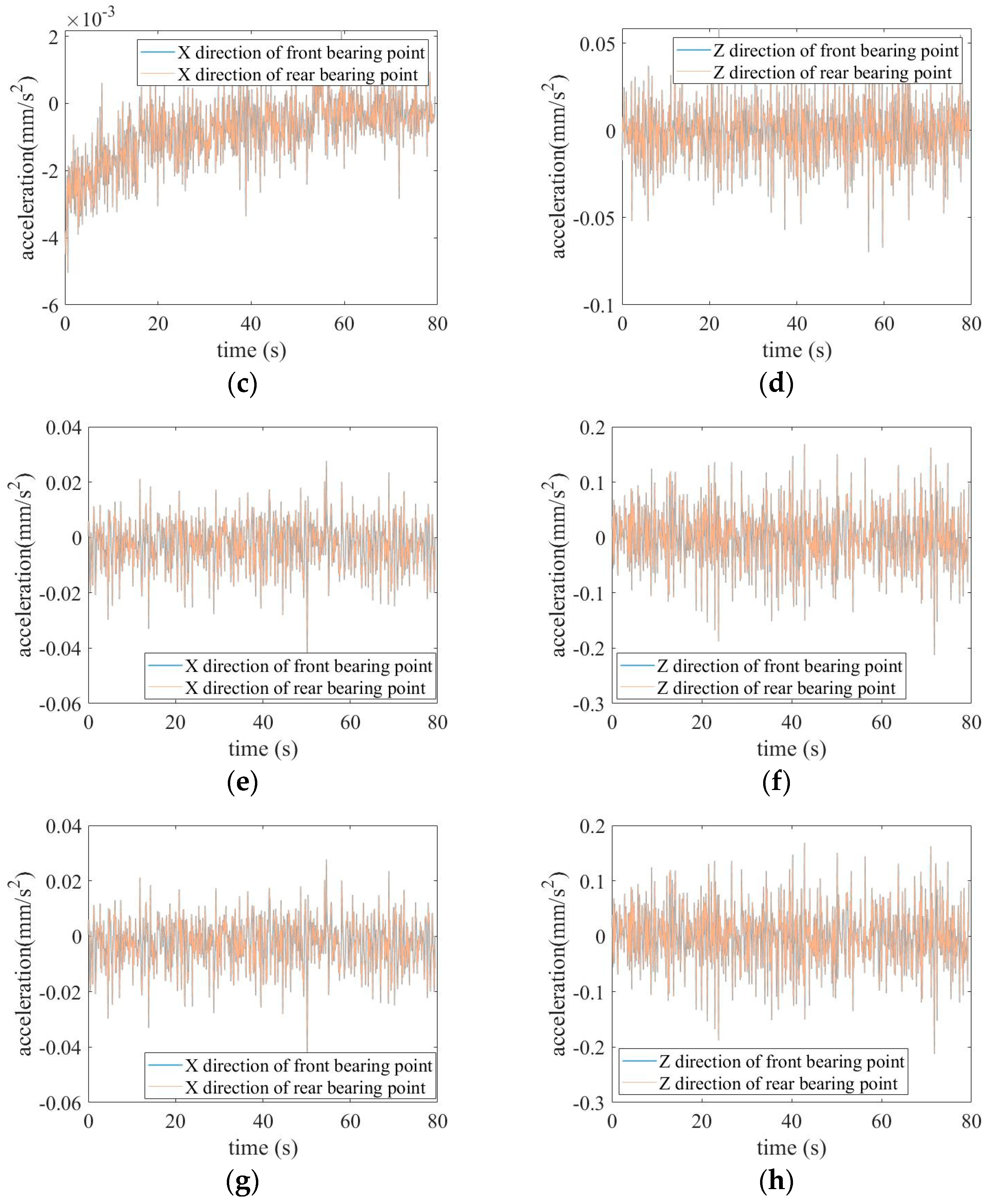
| Serial Number | Name | Model | Range | Accuracy |
|---|---|---|---|---|
| 1 | Trailer system | Non-standard | ||
| 2 | Thermometer | SWP-C80 | ||
| 3 | Airworthiness instrument | Customized | Surge and heave range ±150 mm, roll and pitch range ±35° | Displacement linear error <1.5%, resolution 0.25 mm |
| 4 | Data acquisition instrument | M8128 | ||
| 5 | Acceleration sensor | Three-axis piezoelectric acceleration sensor 1A342E | 10,000 m·s2 | 0.5 mV/m·s2 |
| RMS Values of the Simulation Results in the X Direction | RMS Values of the Test Results in the X Direction | RMS Values of the Simulation Results in the Z Direction | RMS Values of the Test Results in the Z Direction | |
|---|---|---|---|---|
| m/s2 | 0.17803676 | 0.17803676 | 0.17803676 | 0.17803676 |
| Error% | 10.827% | 9.949% | ||
| RMS Values of the Simulation Results in the X Direction | RMS Values of the Test Results in the X Direction | RMS Values of the Simulation Results in the Z Direction | RMS Values of the Test Results in the Z Direction | |
|---|---|---|---|---|
| m/s2 | 0.178034562 | 0.178034562 | 0.178034562 | 0.178034562 |
| Error% | 10.826% | 9.923% | ||
Disclaimer/Publisher’s Note: The statements, opinions and data contained in all publications are solely those of the individual author(s) and contributor(s) and not of MDPI and/or the editor(s). MDPI and/or the editor(s) disclaim responsibility for any injury to people or property resulting from any ideas, methods, instructions or products referred to in the content. |
© 2024 by the authors. Licensee MDPI, Basel, Switzerland. This article is an open access article distributed under the terms and conditions of the Creative Commons Attribution (CC BY) license (https://creativecommons.org/licenses/by/4.0/).
Share and Cite
Zhang, X.; Liu, Y.; Wang, Q.; Xing, Z.; Li, M. Numerical Simulation and Experimental Study on Dynamic Characteristics of Gas Turbine Rotor System Subjected to Ship Hull Excitation. Processes 2024, 12, 2091. https://doi.org/10.3390/pr12102091
Zhang X, Liu Y, Wang Q, Xing Z, Li M. Numerical Simulation and Experimental Study on Dynamic Characteristics of Gas Turbine Rotor System Subjected to Ship Hull Excitation. Processes. 2024; 12(10):2091. https://doi.org/10.3390/pr12102091
Chicago/Turabian StyleZhang, Xin, Yongbao Liu, Qiang Wang, Zhikai Xing, and Mo Li. 2024. "Numerical Simulation and Experimental Study on Dynamic Characteristics of Gas Turbine Rotor System Subjected to Ship Hull Excitation" Processes 12, no. 10: 2091. https://doi.org/10.3390/pr12102091
APA StyleZhang, X., Liu, Y., Wang, Q., Xing, Z., & Li, M. (2024). Numerical Simulation and Experimental Study on Dynamic Characteristics of Gas Turbine Rotor System Subjected to Ship Hull Excitation. Processes, 12(10), 2091. https://doi.org/10.3390/pr12102091






